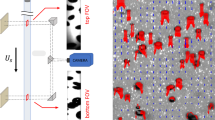Abstract
Many fluid flow applications, for example shock wave propagation and jet flows, involve variation of thermodynamic state variables such as pressure or density of the fluid. In order to fully understand the dynamics of the flow, quantitative information about the variables is desirable during experimental measurements of these applications. The background oriented schlieren (BOS) method is a relatively new quantitative visualization method that uses a digital image correlation algorithm and a numerical solver. It has been applied for measuring the density variation in gaseous fluids. In this paper, the main focus is to apply BOS to the study of shock dynamics in water and provide a detailed protocol for such a method. The experimental results indicate that this technique is a reliable and robust way of probing pressure variations in water for shock impact events.
Similar content being viewed by others
References
Holder, D.W., and North, R.J., “A Schlieren Apparatus Giving an Image in Colour”, Nature 169: 466 (1952).
Settles, G.S., Schlieren and shadowgraph techniques: Visualizing Phenomena in Transparent Media, Springer, Berlin Verlag (2001).
Elsinga, G., Oudheusden, B., Scarano, F., and Watt, D., “Assessment and Application of Quantitative Schlieren Methods: Calibrated Color Schlieren and Background Oriented Schlieren”, Experiments in Fluids 36(2): 309–325 (2004).
Howes, W.L., “Rainbow Schlieren Vs Mach-Zehnder Interferometer: A Comparison,” Applied Optics 24(6): 816–822 (1985).
Venkatakrishnan, L., and Meier, G.E.A., “Density Measurements Using the Background Oriented Schlieren Technique,” Experiments in Fluids 37: 237–247 (2004).
Richard, H., and Raffel, M., “Principle and Applications of the Background Oriented Schlieren (BOS) Method,” Measurement Science and Technology 12: 1576–1585 (2001).
Hargather, M.J., and Settles, G.S., “A Comparison of Three Quantitative Schlieren Techniques,” Optics and Lasers in Engineering 50: 8–17 (2012).
Bell, J.H., Schairer, E.T., Hand, L.A., and Mehta, R.D., “Surface Pressure Measurements Using Luminescent Coatings,” Annual Review of Fluid Mechanics 33: 155–206 (2001).
Meier, G., “Computerized Background-Oriented Schlieren,” Experiments in Fluids 33: 181–187 (2002).
Wagner, W., and Pruss, A., “The IAPWS Formulation 1995 for the Thermodynamic Properties of Ordinary Water Substance for General and Scientific Use,” Journal of Physical and Chemical Reference Data 31: 387–535 (2002).
Hartberger, J.E., Background-Oriented Schlieren Pattern Optimization, Masters thesis, Air Force Institute of Technology, Wright-Patterson Air Force Base, OH (2011).
Yadav, H.S., Murty, D.S., and Verma, S.N., “Measurement of Refractive Index of Water Under High Dynamic Pressures,” Journal of Applied Physics 44: 2197–2200 (1973).
Gladstone, J.H., and Dale, T.P., “Researches on the Refraction, Dispersion, and Sensitiveness of Liquids,” Philosophical Transactions of the Royal Society of London 12: 448–453 (1863).
PIVMAT, URL http://www.fast.u-psud.fr/pivmat/ [accessed 18 December 2012].
Vinnichenko N., Znamenskaya I., Glazyrin F., and Uvarov A., “Study of Background Oriented Schlieren Method Accuracy by Means of Synthetic Images Analysis,” International Symposium on Transport Phenomena, Delft, Netherlands (2011).
Willert, C.E., and Gharib, M., “Digital Particle Image Velocimetry,” Experiments in Fluids 10: 181–193 (1991).
Thielicke, W., and Stamhuis, E.J., “PIVLab.” Website, URL http://www.pivlab.blogspot.com [18 December 2012].
Raffel, M., Willert, C.E., Wereley, S.T., and Kompenhans, J., Particle Image Velocimetry: A Practical Guide, Springer, Berlin (2007).
Fletcher, C.A.J., Computational Techniques for Fluid Dynamics, Springer-Verlag Berlin Heidelberg, New York (1996).
Eliasson, V., Mello, M., Rosakis, A.J., and Dimotakis, P.E., “Experimental Investigation of Converging Shocks in Water with Various Confinement Materials,” Shock Waves 20: 395–408 (2010).
Wang, C., and Eliasson, V., “Shock Wave Focusing in Water Inside Convergent Structures”, The International Journal of Multiphysics 6: 267–282 (2012).
Author information
Authors and Affiliations
Corresponding author
Rights and permissions
About this article
Cite this article
Wang, C., Qiu, S. & Eliasson, V. Quantitative Pressure Measurement of Shock Waves in Water Using a Schlieren-Based Visualization Technique. Exp Tech 40, 323–331 (2016). https://doi.org/10.1007/s40799-016-0036-6
Published:
Issue Date:
DOI: https://doi.org/10.1007/s40799-016-0036-6




